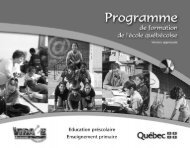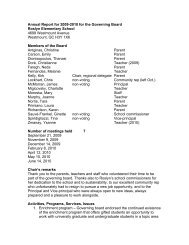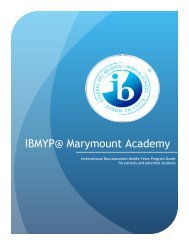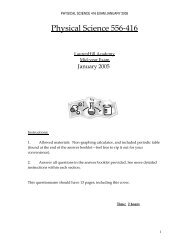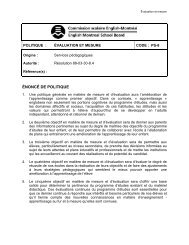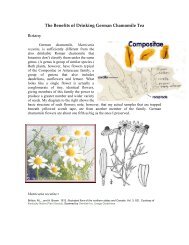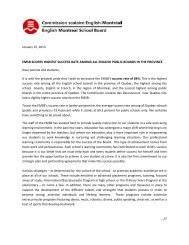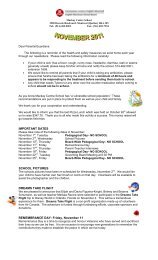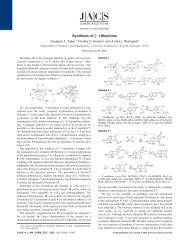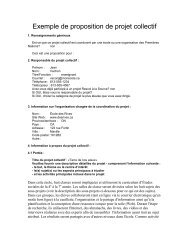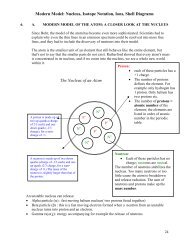Literacy Survival Tips
Literacy Survival Tips
Literacy Survival Tips
You also want an ePaper? Increase the reach of your titles
YUMPU automatically turns print PDFs into web optimized ePapers that Google loves.
6<br />
Suggestions<br />
for Read-Alouds<br />
Picture Books<br />
Amazing Grace by Mary<br />
Hoffman<br />
Charlie Anderson by<br />
Barbara Abercrombie<br />
The Great Kapok Tree:<br />
A Tale of the Amazon Rain Forest<br />
by Lynne Cherry<br />
Mike Mulligan and His Steam Shovel<br />
by Virginia Lee Burton<br />
Rikki-Tikki-Tavi by Rudyard Kipling<br />
The Story of Ferdinand by Munro Leaf<br />
Chapter Books<br />
Because of Winn-Dixie by Kate<br />
DiCamillo<br />
Charlie and the Chocolate Factory<br />
by Roald Dahl<br />
Harriet the Spy by Louise Fitzhugh<br />
The Lion, the Witch and the Wardrobe<br />
by C.S. Lewis<br />
Stone Fox by John Reynolds Gardiner<br />
Stuart Little by E.B. White<br />
Winnie-the-Pooh by A.A. Milne<br />
Common Questions<br />
Many of the teachers in my building skip reading aloud because our<br />
school is under fire to bring up test scores immediately. How do I<br />
justify taking the time to read aloud to my students?<br />
You can’t afford to not take the time to read aloud to your students.<br />
The benefits of read-aloud are many, as students develop background<br />
knowledge, comprehension, robust vocabularies, and critical thinking skills. If<br />
you throw in discussions about the read-aloud, students develop oral language<br />
and deeper understandings.<br />
Because I am a new teacher, I am not sure what books make good<br />
read-alouds for my grade level. Any suggestions?<br />
See the Suggestions for Read-Alouds, Online Resources, and References<br />
provided here, for a start. You do not need to purchase books to read aloud<br />
to your class. You can rely on your school librarian or public librarian for<br />
suggestions. One of my favorite online resources is a website sponsored by Jim<br />
Trelease, author of the best-selling book The Read-Aloud Handbook (2006). Pam<br />
Allyn (2009), teacher and staff developer, suggests books by ages and themes<br />
in What to Read When: The Books and Stories to Read With Your Child—and All the<br />
Best Times to Read Them.<br />
Lori D. Oczkus is a literacy coach, author, and<br />
popular speaker across the United States. Tens<br />
of thousands of teachers have attended her<br />
motivating, fast-paced workshops and read<br />
her practical, research-based professional<br />
books, including Interactive Think-Aloud<br />
Lessons: 25 Surefi re Ways to Engage Students<br />
and Improve Comprehension (Scholastic &<br />
International Reading Association, 2009)<br />
and Reciprocal Teaching at Work: Powerful<br />
Strategies and Lessons for Improving Reading<br />
Comprehension (2nd edition; International<br />
Reading Association, 2010). Lori has extensive<br />
experience as a bilingual elementary<br />
teacher, intervention specialist working<br />
with struggling readers, staff developer,<br />
and literacy coach. She works regularly with<br />
students in classrooms and really knows the<br />
challenges that teachers face in teaching<br />
students to read! You can contact Lori through<br />
her website at www.lorioczkus.com.<br />
Online Resources<br />
International Reading Association<br />
Choices Reading Lists:<br />
www.reading.org/resources/<br />
Booklists.aspx<br />
Featuring annual Children’s Choices,<br />
Teachers’ Choices, and Young Adults’<br />
Choices reading lists.<br />
Jim Trelease’s Home Page:<br />
www.trelease-on-reading.com<br />
Read-aloud expert Jim Trelease<br />
provides many suggestions for<br />
reading aloud to children of all ages.<br />
Read Aloud America Recommended<br />
Books: readaloudamerica.org/<br />
booklist.htm<br />
Suggested read-aloud titles for<br />
infants through high schoolers.<br />
Storyline Online:<br />
www.storylineonline.net<br />
Celebrities read children’s books<br />
aloud.<br />
References<br />
Allyn, P. (2009). What to read when: The books and stories to<br />
read with your child—and all the best times to read them.<br />
New York: Penguin.<br />
Anderson, N.A. (2007). What should I read aloud? A guide to<br />
200 best-selling picture books. Newark, DE: International<br />
Reading Association.<br />
Anderson, R.C., Hiebert, E.H., Scott, J.A., & Wilkinson, I.A.G.<br />
(1985). Becoming a nation of readers: The report of the<br />
Commission on Reading. Washington, DC: National<br />
Institute of Education.<br />
Calkins, L. (with Bellino, L.). (1997). Raising lifelong learners: A<br />
parent’s guide. Cambridge, MA: Perseus.<br />
Laminack, L.L., & Wadsworth, R.M. (2006). Learning under the<br />
influence of language and literature: Making the most of<br />
read-alouds across the day. Portsmouth, NH: Heinemann.<br />
Lapp, D., Flood, J., Ranck-Buhr, W., Van Dyke, J., & Spacek,<br />
S. (1997). “Do you really just want us to talk about this<br />
book?”: A closer look at book clubs as an instructional<br />
tool. In J.R. Paratore & R.L. McCormack (Eds.), Peer talk in<br />
the classroom: Learning from research (pp. 6–23). Newark,<br />
DE: International Reading Association.<br />
Oczkus, L. (2009). Interactive think-aloud lessons: 25 surefire<br />
ways to engage students and improve comprehension.<br />
New York: Scholastic; Newark, DE: International Reading<br />
Association.<br />
Pearman, C.J., Camp, D., & Hurst, B. (2004). <strong>Literacy</strong> mystery<br />
boxes. The Reading Teacher, 57(8), 766–768.<br />
Trelease, J. (2006). The read-aloud handbook (6th ed.). New<br />
York: Penguin.



